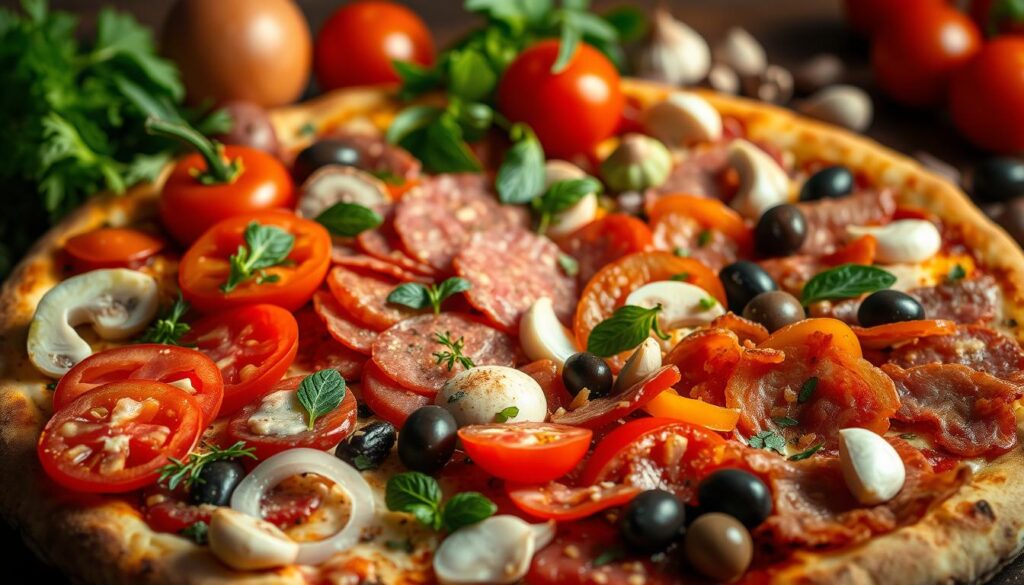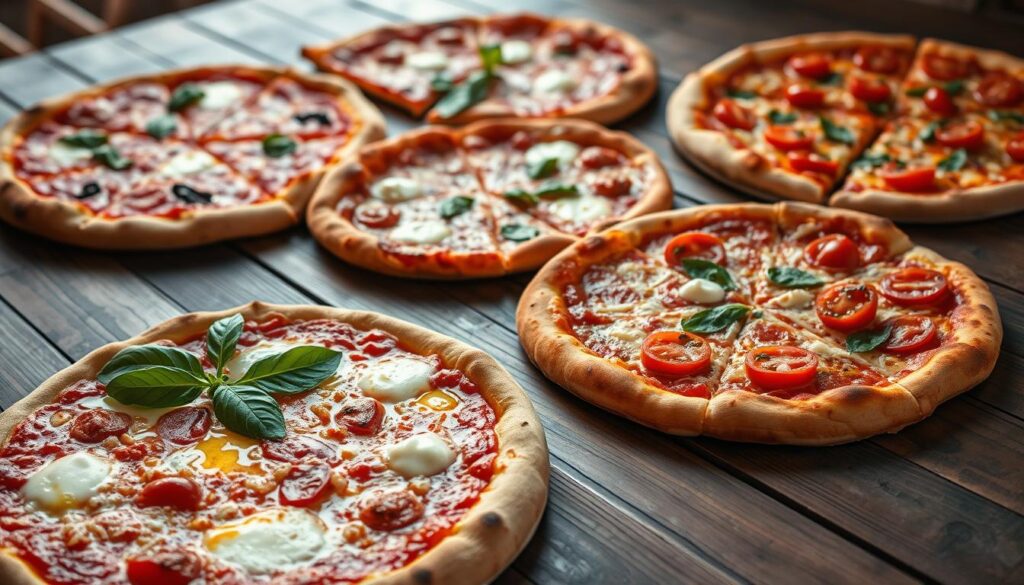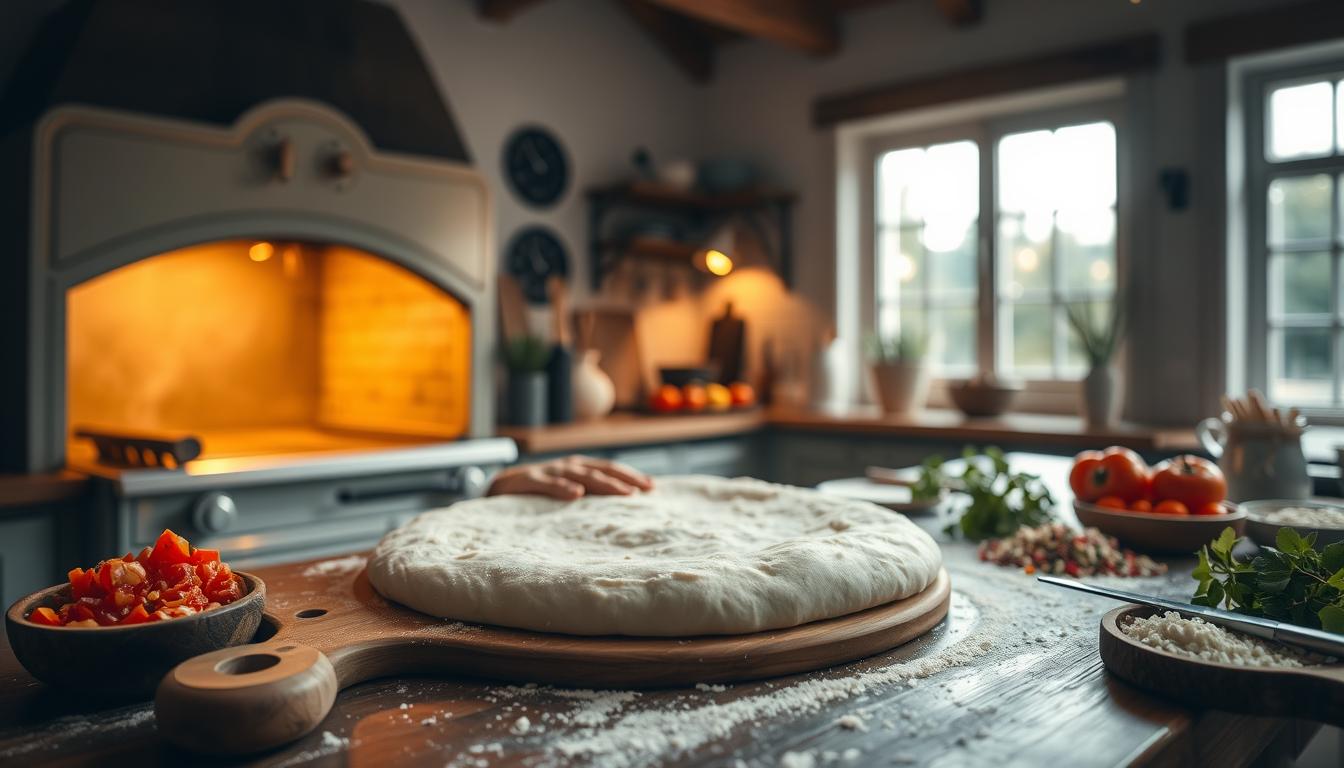Welcome to your ultimate guide on cooking pizza like a pro! This article is for both beginners and experienced home chefs. We’ll show you how to make pizza recipes that rival those from restaurants. You’ll learn about choosing the best ingredients and baking techniques.
Creating the perfect pizza begins with the basics. The right tools, like a pizza stone or steel, are crucial for a crispy crust. Add a balanced dough and fresh toppings, and you’re on your way to a masterpiece. We’ll also cover how to avoid common mistakes and improve your skills.
Ready to elevate your pizza making? Let’s explore tips and techniques to make your homemade pizzas stand out. For inspiration, check out our guide on tasty homemade pizza recipes to get started!
Key Takeaways
- Master the basics of cooking pizza with quality ingredients and equipment.
- Learn essential techniques for perfecting dough, sauce, and toppings.
- Discover expert tips for avoiding common mistakes in pizza making.
- Explore a variety of pizza recipes to suit every taste and preference.
- Enhance your skills with professional techniques for creating restaurant-quality results.
Essential Equipment for Professional Pizza Making
To make a delicious homemade pizza, you need the right tools. The proper equipment ensures a crispy crust, well-cooked toppings, and tasty sauce. Investing in quality gear is key. You can find many homemade pizza recipes online to help you start.
For professional pizza making, you’ll need pizza stones and steel surfaces. They help cook the crust evenly. Also, pizza peels are crucial for moving the pizza in and out of the oven. And, temperature tools and gadgets ensure the pizza cooks at the perfect temperature.
Pizza Stones and Steel Surfaces
Pizza stones and steel surfaces are vital for any pizza enthusiast. They absorb moisture and distribute heat, leading to a crispy crust. Choose between a stone or steel surface based on your preference and pizza type.
Proper Pizza Peels
A good pizza peel is essential for moving the pizza. It should handle high temperatures well, like wood or metal. A pizza peel with a thermometer helps keep your oven at the ideal temperature.
Temperature Tools and Gadgets
Temperature tools are crucial for the perfect pizza cooking. Use a thermometer to check your oven’s temperature and a timer for cooking time. With the right tools and practice, you can create pizzas as good as any pizzeria. Whether it’s a simple margherita or a complex pizza, the right equipment enhances your pizza’s quality and flavor.
The Science Behind Perfect Pizza Dough
Making the perfect pizza dough is an art that needs precision and patience. Whether you’re a pro chef or a home cook, knowing the science of pizza dough can improve your cooking pizza skills. The dough is the base of a great pizza, and mastering it is key for the right mix of taste and texture.
Pizza dough is made from flour, water, yeast, and salt. But it’s how these ingredients work together that matters. Yeast is crucial, as it makes the dough rise, creating air pockets for a light crust. The flour you choose is also important. Bread flour, with its high protein, is best for pizza dough, as it makes the dough stretchy.
Temperature is also key in cooking pizza. The dough needs to rise in a warm, still place for even fermentation. Mixing the dough too much or too little can make it dense. Kneading the dough right helps build gluten, which gives it structure and stretch.
Here’s a quick guide to making the perfect pizza dough:
- Use high-quality bread flour for optimal elasticity
- Activate yeast in warm water to ensure proper fermentation
- Knead the dough until smooth and elastic
- Let the dough rise in a warm place for at least 1-2 hours
- Shape the dough gently to maintain its structure
By understanding the science of pizza dough, you can make top-notch cooking pizza at home. It’s not just about the ingredients—it’s how you mix them. With practice and patience, you’ll make pizzas that are as good as those from your favorite pizzeria.
Mastering the Art of Cooking Pizza at Home
Cooking a delicious homemade pizza is fun and rewarding. With the right techniques and practice, you can make a pizza as good as your favorite restaurant. The key is using the right equipment and ingredients.
Quality ingredients and simple recipes are essential. This way, you can make a tasty and authentic homemade pizza.
Temperature control is crucial when cooking pizza. To get a crispy crust and well-cooked toppings, your oven must be at the right temperature. Here are some tips to help you master cooking pizza at home:
- Invest in a pizza stone or baking steel to help cook your crust evenly
- Preheat your oven to the right temperature, usually between 450-500 degrees Fahrenheit
- Use a thermometer to ensure your oven is at the right temperature
By following these tips and practicing, you can make delicious homemade pizza. Your family and friends will love it. Don’t be afraid to try different recipes and ingredients. With patience and practice, you’ll become a master pizza cook and enjoy perfect homemade pizzas every time.
Selecting Premium Pizza Ingredients
When making a tasty homemade pizza, the ingredients matter a lot. Fresh veggies, meats, and top-notch cheese can really enhance the taste and feel of your pizza. First, pick the pizza sauce you want. You can go for classic tomato or try something different like pesto or arrabbiata.
The pizza toppings you pick also affect the pizza’s taste. Favorites include pepperoni, mushrooms, and olives. But don’t be afraid to mix things up. For a fancy pizza, use mozzarella or parmesan cheese and add fresh herbs like basil or oregano.
Here are some tips for picking the best ingredients for your pizza:
- Choose fresh, seasonal produce for the best flavor
- Select high-quality cheese that will melt well and add flavor to your pizza
- Consider using unique or specialty ingredients to add extra flavor and interest to your pizza
By using these tips and premium ingredients, you can make a delicious homemade pizza that’s as good as any pizzeria. So, why not start today and see what amazing pizzas you can make? With a bit of practice, you’ll be a pizza pro in no time!
Professional Techniques for Pizza Sauce Creation
Making a tasty homemade pizza starts with the sauce. A great sauce can make the whole pizza better. But a bad sauce can ruin it. We’ll look at top methods for making the best pizza sauce, from tomato to white and special sauces.
For a top-notch pizza sauce, start with the best ingredients. You’ll need fresh tomatoes, garlic, and herbs for a classic sauce. For white sauces, mix olive oil, garlic, and heavy cream. Special sauces might include pesto, sun-dried tomatoes, or roasted veggies.
Here are some tips for the perfect pizza sauce:
- Use fresh and high-quality ingredients
- Balance flavors and textures
- Don’t overcook the sauce
- Experiment with different ingredients and recipes
Cooking pizza is an art that needs patience, practice, and the right techniques. Knowing how to make great pizza sauce will help you make pizzas that wow everyone. Whether you’re new or experienced, learning to make pizza sauce is key to making amazing pizzas.
Some favorite pizza sauce recipes include:
- Classic Tomato Sauce: made with fresh tomatoes, garlic, and herbs
- White Sauce: made with olive oil, garlic, and heavy cream
- Pesto Sauce: made with basil, garlic, and olive oil
Proper Pizza Topping Combinations and Placement
Making a tasty homemade pizza starts with the toppings. Pizza toppings are key to the flavor and texture. It’s all about finding the right mix of tastes and textures.
Start with classic combos like margherita or meat-lovers. Or try new pizza toppings for unique flavors. Sweet and savory together can really enhance your pizza. Remember, where you put your toppings matters for even cooking and taste.
Popular pizza toppings include veggies, meats, and cheeses. Don’t be afraid to add special toppings like pineapple or barbecue chicken. Use fresh ingredients and learn different cooking pizza methods to elevate your homemade pizza.

Knowing how to pick and place pizza toppings makes a big difference. It helps you make a pizza that’s both delicious and authentic. Whether you’re new to making pizza or have experience, trying out different pizza toppings and cooking pizza techniques will improve your skills. You’ll soon be making the perfect homemade pizza.
Advanced Stretching and Shaping Methods
Making a great homemade pizza starts with stretching and shaping the dough. With practice, you can make a crust that’s crispy and full of flavor. It’s key to know how temperature and humidity affect the dough’s feel and texture.
For a perfect pizza, a well-stretched crust is essential. Here are some tips to get it right:
- Handle the dough gently to avoid making it tough.
- Let the dough rest a bit after shaping. This makes it easier to stretch.
- Use a pizza peel or parchment paper to move the dough to the oven. This ensures it bakes evenly.
When shaping, think about the pizza type you’re making. For example, a Neapolitan pizza needs a soft crust, while a Roman pizza wants a crispy one. Knowing these techniques lets you make many tasty pizzas.
Here’s a simple table to compare different shaping methods:
| Shaping Method | Crust Texture | Pizza Style |
|---|---|---|
| Hand-tossing | Soft and delicate | Neapolitan |
| Rolling pin | Crispy and well-done | Roman |
| Stretching and folding | Chewy and flavorful | Sicilian |
Learning to stretch and shape pizza dough opens up a world of delicious homemade pizzas. Whether you’re new or experienced, these tips will improve your pizza-making skills. You’ll create unforgettable pizzas that everyone will love.
Mastering Different Pizza Styles
There are many pizza styles to try, each with its own taste and texture. From Neapolitan to New York-style, knowing these styles can make your homemade pizza taste amazing. Start by learning about each style’s crust, sauce, and toppings.
Popular styles include Neapolitan, New York-style, Chicago-style, and California-style. Each has its own look, like thin crust for Neapolitan and thick crust for Chicago-style. By mastering these, you can mix and match toppings to find your favorite homemade pizza. You can even try different styles by ordering online from top pizza places.
Here are some key characteristics of popular pizza styles:
- Neapolitan: thin crust, soft center, fresh toppings
- New York-style: thin crust, foldable, classic toppings
- Chicago-style: thick crust, deep dish, chunky toppings
- California-style: non-traditional toppings, gourmet ingredients

Learning about different pizza styles can improve your cooking skills. Whether you’re new or experienced, trying various styles can introduce you to new flavors and techniques. This can make your homemade pizza even more delicious.
Common Pizza Cooking Mistakes to Avoid
Learning to cook pizza at home is rewarding, but it’s easy to make mistakes. Whether you’re a pro or just starting, avoiding these errors can improve your skills. You’ll be able to make pizzas that taste like they came from a restaurant.
One big mistake is not controlling the temperature right. Many people either cook their pizza too little or too much. This can make the crust soggy or the toppings burnt. To get it just right, use an oven thermometer and follow pizza recipes carefully.
Another common problem is messing with the dough. If you work it too much, it gets tough. If you don’t knead it enough, it’s dense. Letting the dough rest is key for a light, airy crust. For more tips, check out expert advice on perfecting homemade pizza.
Finally, picking the right toppings is tricky. Too many toppings can make the crust soggy and take longer to cook. Choose a few high-quality toppings to keep your homemade pizza balanced and tasty.
By avoiding these mistakes, you can improve your cooking pizza skills. Remember, the more you practice, the better you’ll get. Try different pizza recipes and techniques to find your own style.
With patience and attention to detail, you’ll soon be making pizzas that rival those from restaurants. Happy baking!
Conclusion: Your Journey to Pizza Perfection
Congratulations on finishing this guide to making pizza like a pro! You’ve learned about the right tools, the science of pizza dough, and how to make delicious homemade pizzas. Now, you’re ready to make amazing pizzas.
Keep trying new pizza styles and flavors. Don’t be scared to try new things. The secret to great pizza is to keep practicing. Share your pizzas with friends and family and ask for their opinions. Making and sharing pizza is a fun way to bring people together.
Keep being curious and creative as you make more pizzas. Try new ingredients and follow the latest pizza trends. With hard work and a love for making pizza, you’ll keep getting better and impressing everyone with your creations.
